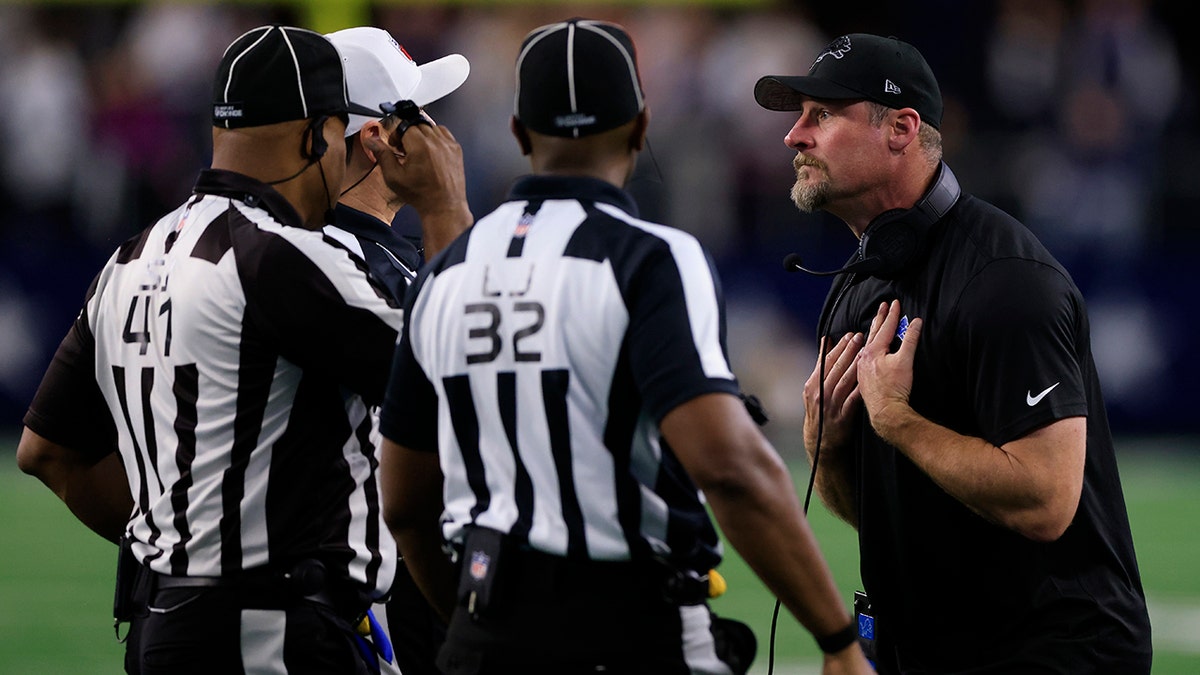The officiating crew from this past weekend’s Cowboys-Lions game has been assigned yet another high-profile game, this one with playoff implications.
Brad Allen and his crew became Public Enemy No. 1 when video appeared to show Detroit offensive linemen Taylor Decker, Penei Sewell and Dan Skipper seemingly discussing eligibility before a two-point conversion that was initially successful, being caught by Decker.
However, referees ruled that Decker never reported as eligible, and thus, a flag was thrown, wiping out the play. The Lions eventually lost, 20-19.
CLICK HERE FOR MORE SPORTS COVERAGE ON FOXNEWS.COM
Dec 10, 2023; East Rutherford, New Jersey, USA; Referee Brad Allen (122) talks with his referee crew during the second half of the game between the New York Jets and the Houston Texans at MetLife Stadium. (Vincent Carchietta-USA TODAY Sports)
In the postgame, the explanations contradicted each other. Lions quarterback Jared Goff said he was sure Decker reported as an eligible receiver and Skipper had not. Allen said Skipper reported to him as an eligible receiver but then went to the tackle spot, which meant he didn’t have to report at all. Decker was already in the game.
NFL fans, and seemingly the Lions, seemed certain that referees deemed the wrong lineman eligible, robbing the Lions of a likely victory.
It was then later revealed that this wasn’t the first primetime scandal involving Allen’s crew.
Well, Allen and Co. will have another tall task on their hands this week.
That crew will be in Baltimore for a crucial matchup between the Ravens and Pittsburgh Steelers.
The Ravens have already clinched the No. 1 seed in the AFC, and Lamar Jackson likely cemented his second MVP Award with his five-touchdown performance this past weekend. So, the Purple Birds don’t have much to play for.

Referee Brad Allen (122) checks the instant replay during the game between the Miami Dolphins and the Philadelphia Eagles on October 22, 2023 at Lincoln Financial Field. (Andy Lewis/Icon Sportswire via Getty Images)
However, this game means everything for the black and yellow.
The Steelers do not control their own destiny for a path to the playoffs, but a victory keeps them alive.
If the Steelers do get the win on the road, they will need one of the Buffalo Bills or Jacksonville Jaguars to lose — or they will need the Colts-Texans matchup to end in a tie.
A loss to the Ravens doesn’t officially knock Pittsburgh out, but they would need tons of help.
If the Steelers lose, they would need the Jaguars to win, the Denver Broncos to lose, and they would need the Colts-Texans game to not end in a tie.

Head coach Dan Campbell of the Detroit Lions reacts to a penalty during a two point conversion attempt against the Dallas Cowboys during the fourth quarter in the game at AT&T Stadium on December 30, 2023 in Arlington, Texas. (Ron Jenkins/Getty Images)
CLICK HERE TO GET THE FOX NEWS APP
But one thing is for certain: The Steelers do not want to have to root for a game to not end in a tie, so one could assume Mike Tomlin will have lengthy discussions with Allen and crew leading into the 4:30 p.m. ET matinée this Saturday.
Tomlin said Mason Rudolph will get the start despite Kenny Pickett being healthy.
Fox News’ Ryan Gaydos contributed to this report.
Follow Fox News Digital’s sports coverage on X and subscribe to the Fox News Sports Huddle newsletter.


















